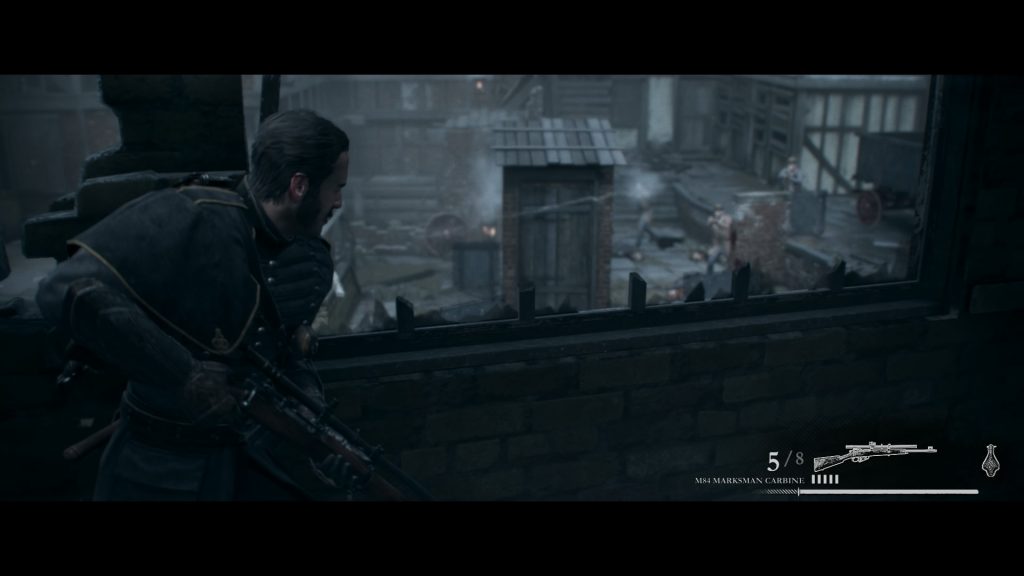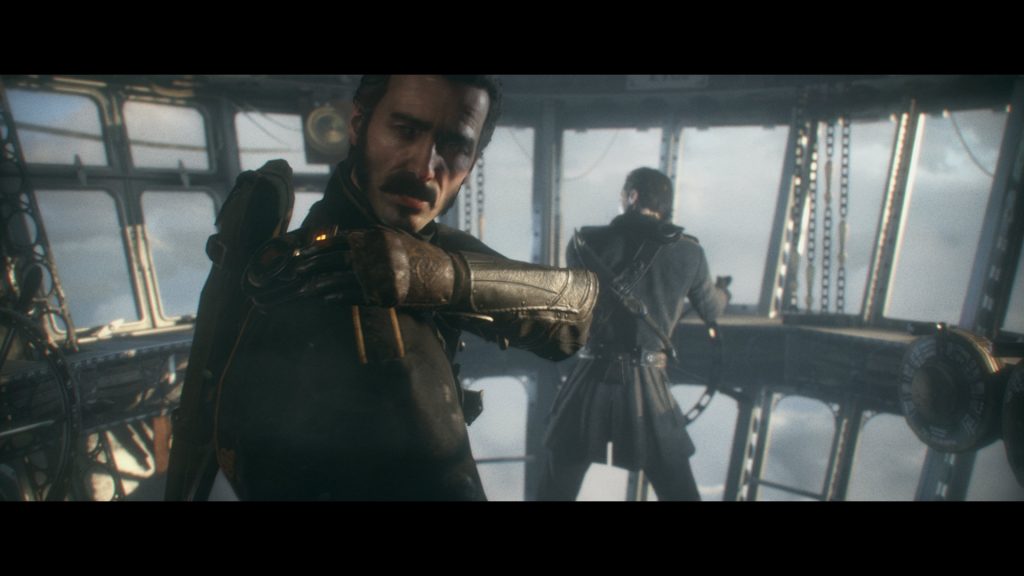The Games That Made Me – Joseph Gallagher
‘I found myself on the path less trodden when reflecting on 2015’s The Order 1886. Published by Sony Santa Monica and developed by Ready At Dawn, the title was polarising to say the least. With praise being directed at its stunning production values but not much else. However, for me the game succeeded in every department, shaping how I now view the medium and what I consider to be a meaningful experience. It’s entered my list of all-time favourite games, leaving an everlasting impression, and all for the right reasons.’
You had me at hello…
The menu screen of Ready At Dawn’s 2015 release The Order 1886 rendered me completely transfixed. Praise for Jason Graves’ score cannot be high enough, with the rousing The Knights Theme serving as a worthy introduction to the tone of the universe. The score also successfully set the game apart from its peers by creating a precedent for the level of polish this title needed to attain in order to separate it from other games.
That level of polish failed to wane at any point during the entire experience and ensured I was enraptured throughout. It was apparent that nothing about its presentation was a mistake. The Order achieved the task of providing the player with a remarkable cinematic gaming experience. Subtle details created a faultless sense of immersion; subtitles, chapter headings, button prompts, and dates all appeared with a deliberate aesthetic fade, the game seemed to be taking inspiration from Tomas Alfredson’s 2011 film Tinker Tailor Soldier Spy.
The opening salvo continued the British sensibilities with accents and colloquialisms instantly familiar to anyone living in the capital of the motherland. We’re introduced to Sir Galahad, a member of Her Majesty’s Royal Knights, whom we take the role of. The proceeding act plays out with a certain cinematic flair, rather than a typical game intro. The protagonist of Ready At Dawn’s new IP is tortured, and after enduring a prolonged cutscene we’re given the opportunity to assist Galahad in his predicament. An appropriate moment is chosen to bring the notorious quick time event (QTE) mechanic into the fray. Pressing the button shown on screen in a timely manner gets Galahad out of sticky situations and allows the story to progress. The prologue continues with your standard control tutorial and more QTE moments, nothing out of the ordinary. Galahad flees his captors [no spoilers] through the catacombs of Westminster and we finally come to a halt atop a fortified wall, surrounded. The entire opening sequence is reminiscent of numerous television dramas, fitting as the script is penned by Kirk Ellis whose writing credits find him as the scribe of various network television shows. Albeit this was done with a tad more finesse.

“Close your eyes and you’ll believe you’re really standing on a balcony in [a version of] Victorian London; horses and carts on the street below pass you by, while ambient noise of the wind, voices in the distance, and the sound of trains rushing by all work together to create an impressively immersive world. All expertly mixed.”
When we’re re-introduced to the story we’re met with possibly my favourite scene in gaming, perhaps only bested by any number of set pieces in Naughty Dog’s Uncharted series; Galahad stands confidently on a balcony, conversing with a fellow Knight over a radio, possible due to electrical devices being commonplace in The Order’s alternate timeline. The Knight, now draped in attire fit for, well… a knight, overlooks London. Smoking chimneys and rooftop billboards donning the skyline. This scene was the first of many to have me completely glued to the screen. The developers once again showcased their mastery and presented a fully thought out and realised stage, rife with polish and detail. Though a static scene with Galahad confined to the single balcony, the developers let no detail pass. The production values really do surpass any expectations, all aspects working together in beautiful unison. The expert sound design wraps the stunning visuals in a very polished presentation. Close your eyes and you’ll believe you’re really standing on a balcony in [a version of] Victorian London; horses and carts on the street below pass you by, while ambient noise of the wind, voices in the distance, and the sound of trains rushing by all work together to create an impressively immersive world. All expertly mixed.
You’re then invited to take the controls for a short while to lead Galahad off the rooftop. Upon closing the door behind you and finding yourself in a sparsely decorated attic, the sound design once again astounds, allowing the player to still hear the busy exterior but somehow sounding convincingly like you’re actually inside. The lighting also creates a realistic interior, accurate shadows are cast and beams of light illuminate the surroundings. Unfortunately, according to most critics, here’s where the game begins to falter.
We’re already acquainted with the QTE mechanic, which rears its head sporadically throughout the game, and after a period of walking and light exposition, we’re introduced to the game’s second mechanic: shooting. Therein lay the problem. The controversy surrounding The Order pertains to just that: the mechanics. And the fact that those two were the only notable ones. The -what makes a game a game- debate was raging, with opinions falling on both sides but the consensus leaning towards the suggestion that a game needed to have well-rounded gameplay as well as an engrossing story, but importantly, the player must be given the reigns more often than not.
Arguably, in most titles, performing QTEs and shooting enemies would appease enough. However, the criticism in this case was directed at how much, or how little the player was actually allowed to shoot said enemies. In the case of The Order, you face rebels pitted against the empire, and insane asylum escapees, some afflicted with the ability to transform into werewolf-like hybrids known as Lycans – The Order’s centuries-long nemeses. Combat took the player to notable London locations (The Underground, London Hospital, et al), with our Knight travelling wherever the Order wills him to. These environments make narrative sense, serving as transitions between cutscenes rather than the other way around (not to be taken as a negative). The game takes a traditional level-based approach to its structure. Unique setpieces are the subject of each chapter. Combat, which also involves a melee mechanic if you run up to an enemy and press ![]() to despatch Galahad’s fist into their face for an instant kill, is bridged by moments of character interaction and light exposition. Thankfully these moments of downtime were never long or dragged out, instead functioning as an entertaining transition between bouts of gunplay.
to despatch Galahad’s fist into their face for an instant kill, is bridged by moments of character interaction and light exposition. Thankfully these moments of downtime were never long or dragged out, instead functioning as an entertaining transition between bouts of gunplay.
“My weapon of choice was the three-barrelled coach gun, a firearm of such notoriety that enemies exclaimed whenever I un-holstered it. And for good reason: it blew their limbs off.”
Undeniably, there weren’t very many instances of gameplay in The Order. But what there was left me feeling very satisfied. The armoury is limited but distinctive; players were given the choice of pistols, rifles, and a couple of heavy weapons utilising unique traits such as electricity and fire (the Thermite gun). My weapon of choice was the three-barrelled coach gun, a firearm of such notoriety that enemies exclaimed whenever I un-holstered it. And for good reason: it blew their limbs off. Regardless of weapon though, pulling the trigger and landing a hit always felt satisfying, with punchy sounds and dramatic animations. I relished the opportunity to take aim for a headshot.
The story here – one of loyalty, betrayal, and redemption, was enough to keep me going to the end (and to revisit the tale more than once). Dialogue and exchanges between characters were engrossing, with a fantastic script containing appropriately classical language, allowing the voice actors to provide convincing and nuanced performances. Visuals and production design in general remained amazing throughout, the lighting in particular created almost hyper-realistic environments, on many occasions reducing me to a bewildered spectator. The gameplay was perfect, with guns feeling heavy and shots resulting in satisfying pleasure. Not enough can be said about the polish and attention to detail that was poured into The Order.

I still think about The Order to this day. It gave me an experience unlike any other game. With all the cogs obsessively polished to make sure the machine performs at its very best. All the intricate details; the script, minuscule details in the environment, the visuals, the sound, all blend together to produce an unforgettable experience. The Order came out at a transitionary period, with gamers and critics alike wanting a more flexible experience, with players seeking more freedom, like that found in open world games where one is able to approach an objective or mission as one sees fit (within the boundaries on the game’s engine). Titles that failed to adopt this style of gameplay were starting to be seen as irrelevant or stuck in the past.
But instead of gaining two distinctive genres, we lost one. Something can be said for a polished, linear, cinematic game. A piece of interactive entertainment that provides an engrossing story for the player to uncover. The Order showed us that a linear experience can allow a talented developer to hone their skills into crafting a simply beautiful game. An assault on the senses in such a concentrated space means we feel like we’re really there. I’ve had enough of “acceptable” sandbox games, I no longer care for bugs and glitches or breaking mission structures by just chucking a rocket at my target. I want to be taken through lovingly created levels and narratives. I want to be part of a story that leaves me satisfied after every gunfight or puzzle. I miss cinematic games, and I, for one, have a special place in my heart for The Order 1886.
Qualitative rating
The Order 1886 delivered on all fronts with little to fault, and is an unforgettable game that I cannot praise highly enough. The story, production, satisfying gameplay, and fervent level of polish all come together to provide a remarkable cinematic interactive experience.
Qualitative rating
The Order 1886 delivered on all fronts with little to fault, and is an unforgettable game that I cannot praise highly enough. The story, production, satisfying gameplay, and fervent level of polish all come together to provide a remarkable cinematic interactive experience.




